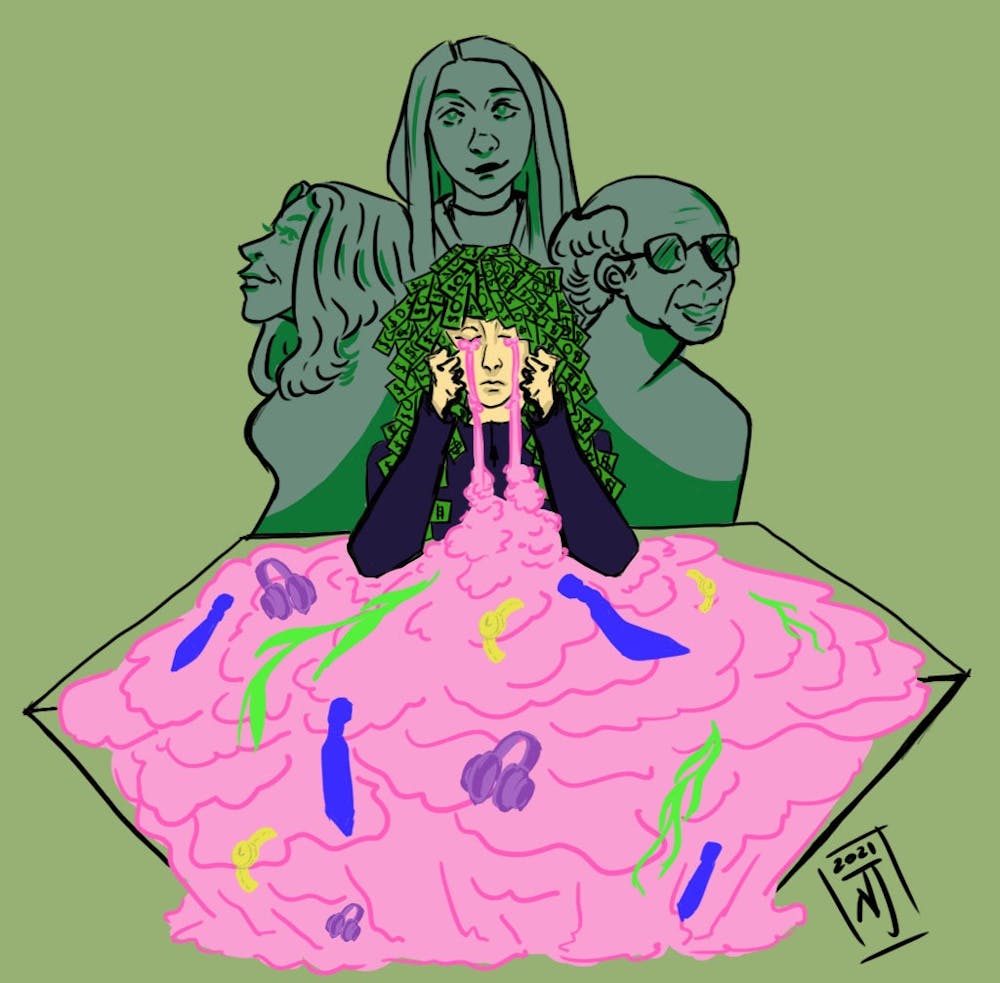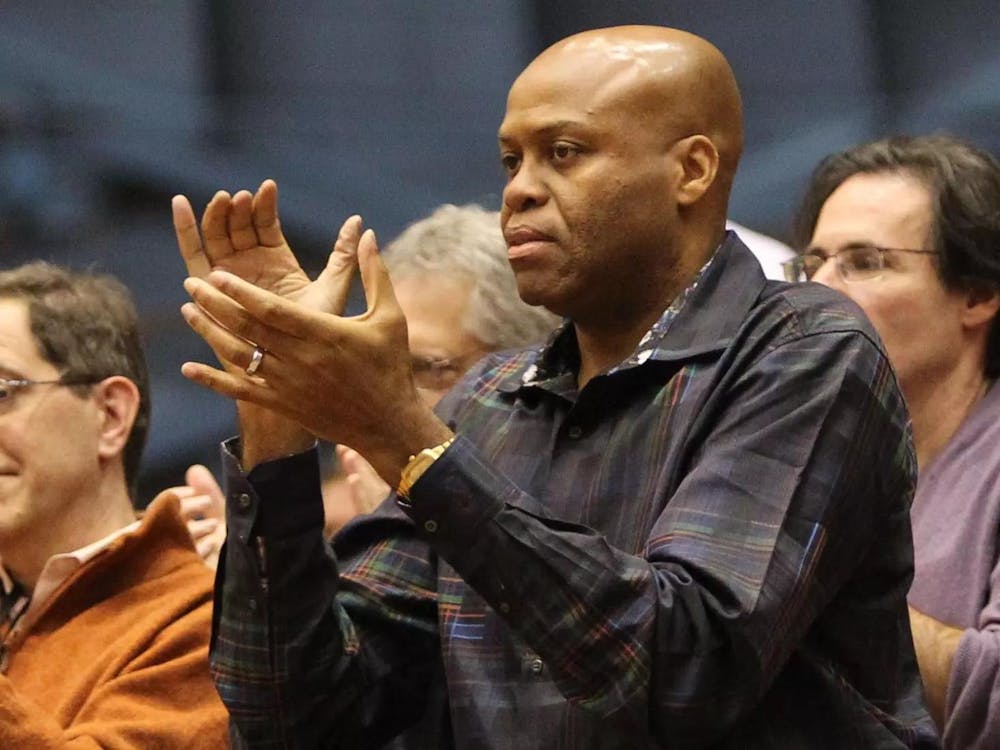The indie film “Kajillionaire,” released during the height of the COVID-19 pandemic, couldn’t have arrived at a more timely moment. Meditating on themes of intimacy and isolation, “Kajillionaire” is relevant to the predicaments of University students who feel alienated by social distancing guidelines and the tragedies of the COVID-19 pandemic. The film contains excellent performances by a talented cast of actors, a multitude of absurd yet aesthetically invigorating elements, and incremental character development that discloses important truths about the human condition. “Kajillionaire” explores a wealth of themes and arrives at an unmistakable conclusion: love is a priceless commodity that trumps all the trappings of material wealth.
The plot centers on the plight of Old Dolio Dyne (Evan Rachel Wood), an awkward 26-year old woman who sports outlandishly long hair, speaks in a gruff monotone, and dons an oversized tracksuit. She lives with her parents, Robert and Theresa (Richard Jenkins and Debra Winger), who have raised Old Dolio with scant displays of love or affection. The Dynes’ dynamics are stiff and hardheaded; their interactions could be likened to those of a dubious business partnership rather than a conventional family.
The Dynes reside in a dilapidated one-floor office building with a leakage issue (it regularly bleeds with uncanny pink foam, calling into question the boundaries that demarcate reality and fiction in the film) in the film’s version of Los Angeles. The dysfunctional family embarks on daily missions during which they scour public spaces for lost change, steal contents from others’ mailboxes, and re-sell unwanted gift certificates. In other words, the Dynes live off the minimum of money necessary to survive in Los Angeles and maintain this precarious lifestyle through underhanded ways. If multimillionaire media moguls are on the far end of affluence, then the Dynes reside on the diametrically opposed end of indigence, barely scraping by on a day-to-day basis.
The conflict of the film emerges when the Dynes receive notice from their landlord that the family has a single week to make an outstanding payment toward their rent. After conceiving of a radical money-making scheme, the Dynes end up on an airplane, where Robert and Teresa become acquainted with a gregarious woman named Melanie (Gina Rodriguez), who appears to be more or less the same age as Old Dolio.
Over the film’s course, the dynamics among the Dynes increasingly grow more tense and fractured throughout the film, with Melanie’s effervescent presence serving as a firm juxtaposition to the dismal reticence of Old Dolio, who gradually comes to grasp certain unsettling truths about her emotionally impoverished upbringing.
The psychological journey that Old Dolio undergoes as she experiences disconcerting revelations invites viewers to reflect on their own family dynamics. Most notably, Old Dolio’s transformation highlights the impact that all of our childhood experiences exert on our overall development, notwithstanding how traumatic or how blissful our upbringings may have been. Every behavior and personality trait that we possess as adults has, in some way, been influenced by a convergence of environmental factors over which the hapless child versions of ourselves exercised little control, and nobody serves as a testament to this startling fact more than the emotionally stunted, survivalistic Old Dolio.
Miranda July, director of “Kajillionaire,” has said that the film encapsulates the feelings that accompany viewing one’s parents as strangers: “[It’s the] beginning for all of us of growing up. When before, everything you thought was the world was just them.” Indeed, “Kajillionaire” encompasses many eye-opening themes: it simultaneously serves as an allegory for how overwhelming the world can be when we venture out from the confines of our childhood restrictions, a horror story about profound parental neglect, and a surreal meditation on the universal yearning for intimacy and connection.
While “Kajillionaire” delves into provocative themes that probe resonant elements of the human condition, the film would miss the mark in driving home these observations if not for the arresting performances of its cast.
Evan Rachel Wood’s taciturn performance and dull monotone throughout the film might strike some viewers as forced and affected, but her rigid mannerisms and behaviors conversely portray the extent to which her character represents the outcome of years of parental trauma and neglect. Her diminished reactions and absent stares belie her fervent emotional world, a realm in which her repressed pain simmers to a boil yet remains all but dormant until later events precipitate their release.
Similarly, Richard Jenkins’ and Debra Winger’s performances as Robert and Teresa are so alien, so unsettling, and so aloof that film viewers can’t help but feel an overwhelming sense of unease creeping in as they watch the pair’s strange dynamics unfold on screen. Coupled with their innocuous appearances (the on-screen couple could superficially resemble someone’s older, laid-back next-door neighbors) and their seamless transitions between acting in deceptively friendly ways to behaving like emotionless droids, Robert and Teresa inhabit personas that are at once recognizable yet deeply uncomfortable. The coexistence of their greediness and friendly pretenses show how someone seemingly normal can deceive us into overlooking the more disturbing qualities that lurk beneath the surface.
In contrast, Gina Rodriguez’s performance as Melanie serves as a foil to Wood’s glum and emotionally repressed Old Dolio. Melanie brims with refreshing normalcy, though she, too, has experienced her fair share of family-related dilemmas. Her prominence in the film after she becomes involved with the Dynes’ schemes provides a catalyst for Old Dolio’s gradual process of emotional catharsis. Old Dolio is constantly taken aback, almost affronted, by Melanie’s liveliness and friendliness, and, at least initially, Old Dolio refrains from responding to Melanie’s overtures due to the unfamiliarity that the former assigns to the latter’s warm openness.
Although this fraught dynamic may strike most viewers as symptomatic of Old Dolio’s trauma, it’s possible that the imposed isolation of the pandemic may have imbued us all with at least a modicum of Old Dolio’s lack of social know-how and timidity. After all, like Old Dolio’s incredulity at Melanie’s outgoing personality, many of us who have succumbed to the solitude of pandemic life have in turn found ourselves regarding the prospect of multi-person gatherings as relics of a long bygone era or an instance of extreme socialization, to the likes of which we feel we can no longer reasonably aspire, byproducts of how starkly our social muscles may have atrophied during this isolating time.

Beyond the gut-wrenching emotional portrayals and toxic family dynamics, “Kajillionaire” stands apart for its striking visuals. The film’s mise-en-scene has many surreal elements, including pink foam that constantly drips from the ceiling of the Dynes’ dilapidated office, aptly timed earthquakes that seem to mark Old Dolio’s moments of epiphany, and the smattering of stars that flicker in the darkness of a gas station restroom during a large earthquake. These aspects of the film grant it a dream-like atmosphere standing in stark contrast to the nightmarish ways of the Dyne family, who swindle, steal, and con others so seamlessly that their ploys border on the fantastical.
The fantastic visual elements and heart-rending plot of “Kajillionaire” distinguish it as a film uniquely suited for these trying times. Miranda July’s eccentric directing decisions converge with the incredible performances of the cast to produce a resonant film amid the pandemic. With its surrealist elements and emotional revelations, “Kajillionaire” is an avant-garde cinematic artwork that simultaneously defies explanation and seeks to speak to universal desires and fears. In other words, “Kajillionaire” mystifies viewers and acknowledges the unspoken anxieties that pervade life, a timely theme during pandemic and polarization in our society.








